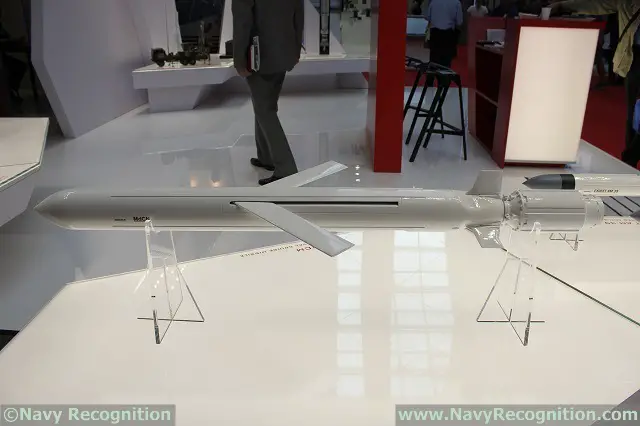Breaking news
DCNS is Showcasing the Scorpene Submarine with Cruise Missile and AIP technology at MSPO 2015.
| 2015
| |
|||
| a | |||
Naval
Industry News - France, Poland |
|||
DCNS
is Showcasing the Scorpene Submarine with Cruise Missile and AIP technology
at MSPO 2015 |
|||
DCNS is featuring the Scorpene
diesel-electric submarine (SSK) at MSPO 2015, the International
Defence Industry Exhibition in Poland which takes place in Kielce, Poland,
from the 1 to 4 September 2015. DCNS proposes to the Polish Navy the
sea proven Scorpene class submarine for the Orka program. Featuring
a highly performing acoustic discretion, an increased submerged autonomy
thanks to the latest-generation air-independent propulsion (AIP) technology,
the Scorpene has the capacity to deploy MBDA's Naval Cruise Missile
(NCM). |
|||
 Scorpene Submarine, MBDA AM39 Exocet and Naval Cruise Missile scale models on DCNS stand at MSPO 2015 |
|||
The
specific conditions of the Baltic Sea are favourable for the use of
submarines and make them very difficult to detect, unlike land and air
platforms for launching deterrent weapons. The ability to operate underwater
for several weeks, provided by air-independent propulsion systems, in
particular, makes undetectable and omnipresent modern submarines the
most effective carriers of cruise missiles. Cruise missile submarines, such as the Scorpene built by DCNS, have an effective offensive weapon system able to provide the deterrent capability wanted by Poland. This deterrence does not require a large number of missiles. The important factor is the ability to strike critical targets, with a high probability of success, within a radius of several hundred kilometres around the waters in which submarines can hide. No other weapon system can provide this capability. The cruise missile submarines will provide a guarantee of national protection. Furthermore, they will reinforce the diplomatic weight of Poland on the international stage. The fact that the Polish armed forces have the capability to launch cruise missiles from submarines will have a significant influence for Poland within NATO and the European Union, where only a few countries possess this capability. Poland will thus be able to join a very select club of countries with influence on the international stage. |
|
Xavier Mesnet, Surface Ships and Submarines Marketing Director at DCNS,
answered our questions about the Scorpene submarine during MSPO 2015. |
|||
Talking
to Navy Recognition, Xavier Mesnet (Surface Ship and Submarine
Marketing Director at DCNS) explained that there will be important transfer
or technology for the construction of the submarines in Poland. "We
want to give Poland full autonomy and full sovereignty on its submarines.
This is covered by two aspects: The first one is Naval Cruise Missile
that will give deterrence capability and the second aspect is autonomous
propulsion with the fuel cell AIP designed by DCNS." With the planned decommissioning of the Polish Navy's four Kobben (Type 207) class submarines by the end of 2016 and of the ORP Orzel (Kilo class) in 2022, DCNS has a solution to maintain the skills of Polish Navy sailors until the next generation of submarines are operational. |
|||
 Naval Cruise Missile scale model on MBDA stand at MSPO 2015 |
|||
The
ability to strike strategic and military targets with exceptional precision
from extended stand-off ranges has become a key operational requirement.
MBDA’s experience in this area has already been proven with the
development and entry into service of the Storm Shadow / SCALP air-launched
cruise missile. This combat-proven missile system, with its unmatched
capabilities, was the result of a multi-national European programme (France,
Italy and the UK). Bringing together these European skills, MBDA is now
developing NCM to meet the requirement issued by the French Ministry of
Defence for a long-range cruise missile capable of being launched from
surface ships and submarines. In December 2006, MBDA was awarded a contract from the DGA for the development and production of the NCM. The very first firing took place from a Sylver A70 VLS system (same as on the FREMM Frigates) in May 2010. The first sub-surface test firing occured in June 2011. MBDA started mass production of the missile in 2015. IOC (initial operating capability) was achieved for the FREMM Frigates this year as well with the first live launch from Aquitaine frigate on May 19. IOC for the Barracuda next generation SSNs of the French Navy is planned for 2018. To learn more about MBDA's NCM read our focus on the missile |
|||


























